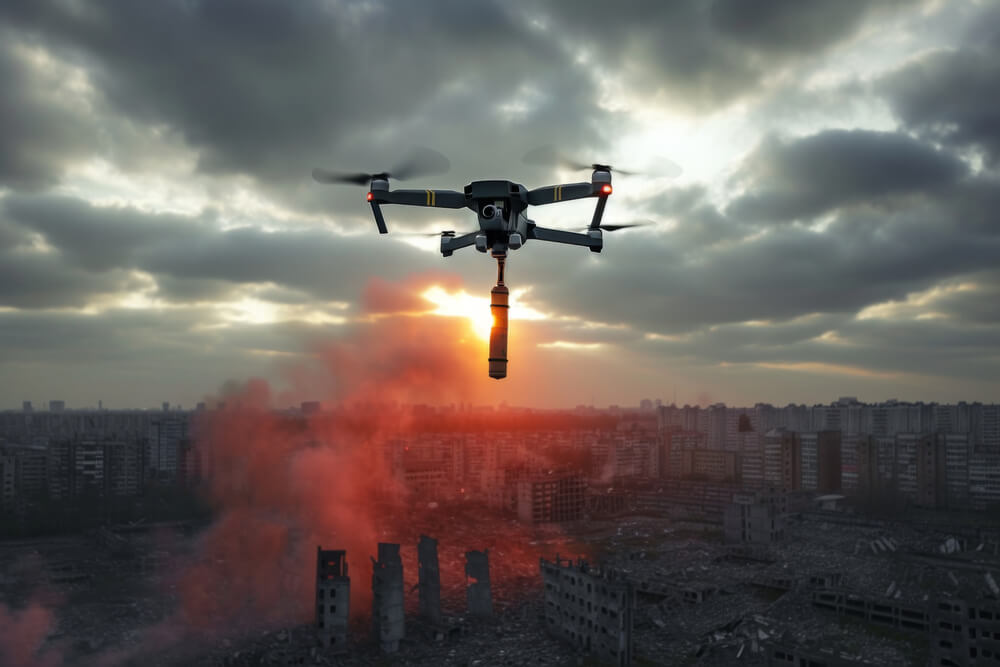The Rise of Kamikaze Drones in Modern Warfare
As these unmanned aerial vehicles (UAVs) grow more common in military operations, kamikaze drones, or loitering munitions, enhance both surveillance and strike capabilities by hovering and targeting with precision. Their affordability is a significant factor driving their adoption; unlike traditional aircraft or missiles, kamikaze drones are less expensive to produce and deploy, making them an attractive option for militaries seeking to maximize their operational performance while minimizing costs. Their ability to perform precision strikes while reducing the risk to human pilots further strengthens their appeal in modern warfare.
Kamikaze drones are small and have low radar signature, which makes them difficult to detect and intercept, allowing them to penetrate enemy defenses and carry out surprise attacks with minimal warning. This makes them particularly capable in asymmetric warfare scenarios where traditional military assets might be vulnerable. Their integration into military operations underscores a broader trend towards autonomy and precision in warfare, highlighting the ongoing transformation of how military campaigns are conducted in the 21st century.
Strategic Advantages of Using Kamikaze Drones
One of the most strategic advantages of using kamikaze drones in military operations is their unparalleled precision targeting capability. These drones can hover over the battlefield, gather real-time intelligence, and engage targets with pinpoint accuracy, significantly increasing the competence in military operations. Unlike traditional weaponry that may cause collateral damage, kamikaze drones can isolate and strike specific threats, reducing unintended consequences.
Kamikaze drones can operate in hostile environments without endangering human life, a crucial factor in modern warfare where protecting personnel is paramount. The production and operational costs of kamikaze drones are significantly lower, allowing military forces to deploy more assets without the financial burden typically associated with high-tech weapon systems. This affordability, combined with their tactical versatility, makes kamikaze drones a revolutionary asset in the evolving landscape of military engagements
Technological Advancements Driving Drone Capabilities
The primary development is the integration of better sensors, enabling kamikaze drones to operate with greater precision and awareness in military operations. These advanced sensors enable the drones to gather and process real-time data with exceptional accuracy, ensuring that targets are identified and engaged with minimal error. The integration of Artificial Intelligence (AI) into kamikaze drones is also revolutionizing their operational capabilities. AI systems can process vast amounts of battlefield data rapidly, enabling drones to make autonomous decisions.
Autonomous features enable kamikaze drones to independently loiter, assess threats, and execute precision strikes in military operations. This reduces the burden on personnel, allowing them to focus on strategic objectives. Plus, the advancements in drone capabilities, including improvements in propulsion and energy proficiency, extend the operational endurance of kamikaze drones, allowing them to engage in prolonged missions without the need for frequent refueling or maintenance.
Ethical Considerations in Deploying Kamikaze Drones
As kamikaze drones are increasingly equipped with Artificial Intelligence (AI) to operate independently, there is an ongoing debate about the moral implications of machines making life-and-death decisions without human intervention. This autonomy could potentially lead to scenarios where drones engage targets based on algorithmic assessments, increasing the risk of unintended consequences in volatile combat environments. The possibility of AI-driven weapon systems making ethical decisions challenges traditional warfare principles that focus on human accountability in military operations.
The reality of warfare often involves rapidly changing conditions and complex environments that can lead to unintended casualties. Ensuring compliance with international humanitarian law, which seeks to protect civilian lives and property, becomes increasingly challenging as the technological capabilities of military drones advance. The use of kamikaze drones in military operations raises legal concerns, blurring the line between lawful and unlawful actions. The remote nature of drone use complicates accountability, making it important for policymakers and legal experts to address these challenges.
The Future Impact of Kamikaze Drones on Global Defense Strategies
Their affordability, precision targeting capabilities, and potential for autonomous operation make them attractive resources for modern militaries seeking to improve their operational performance while minimizing risks to human personnel. In the coming years, kamikaze drones are expected to drive a shift towards more agile and responsive military operations, enabling forces to adapt to rapidly changing combat situations with unprecedented speed and accuracy. This adaptability is essential in addressing asymmetric threats and non-state actors, where traditional military assets may be less impactful.
Integrating kamikaze drones into national defense strategies could reshape international relations. Countries with advanced drone fleets may gain a strategic advantage, leading to new alliances and rivalries as states try to counterbalance drone-equipped adversaries. The widespread use of kamikaze drones could change warfare, focusing on precision, speed, and technology. Ethical and legal challenges surrounding autonomous weapons will influence global defense strategies, as international norms adapt to these new technologies.


Recent Comments